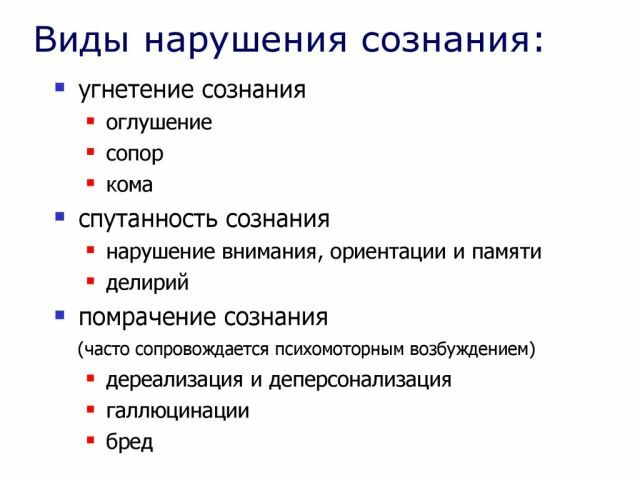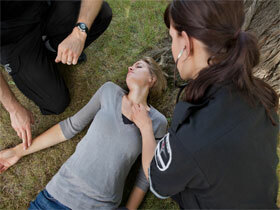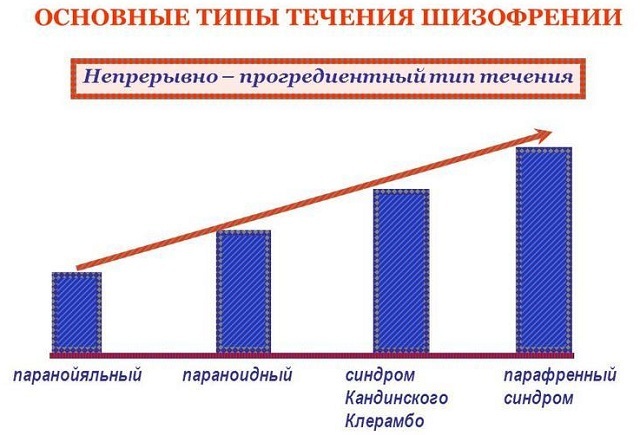- Stupor( sopor) .In Latin, this word means "numbness".The patient in the stupor ceases to react to the surrounding reality. The reaction does not cause even a strong noise and inconvenience, for example, a wet bed. During natural disasters( fires, earthquakes, floods), the patient does not realize that he is in danger, and does not move from his place. Stupor is accompanied by motor disorders and lack of response to pain.
- Twilight confusion of consciousness .This type of violation is characterized by a sudden and suddenly disappearing disorientation in space. The person retains the ability to reproduce automated familiar actions.
- Syndrome of the locked person .This is the name of a condition in which the patient completely loses the ability to speak, move, express emotions, etc. The surrounding people mistakenly believe that the patient is in a vegetative state and can not adequately react to what is happening. In reality, a person is conscious. He is aware of everything that is happening around him, but because of the paralysis of the whole body he has no opportunity even to express emotions. Only the eyes remain movable, with the help of which the patient communicates with others.
- The akinetic mutism of .This is a condition in which the patient is conscious, but there is confusion. His
 retains an understanding of the surrounding reality. The patient easily finds the source of sounds, reacts to pain. At the same time, he completely or practically loses the ability to speak and move. After their cure, patients tell that they were fully aware of what was happening around them, but some force was preventing them from adequately reacting to reality.
retains an understanding of the surrounding reality. The patient easily finds the source of sounds, reacts to pain. At the same time, he completely or practically loses the ability to speak and move. After their cure, patients tell that they were fully aware of what was happening around them, but some force was preventing them from adequately reacting to reality. - Hypersomnia .Characterized by a constant desire to sleep. At night, sleep lasts significantly longer than it should be. Awakening usually does not occur without artificial stimulation, for example, an alarm clock. It is necessary to distinguish 2 types of hypersomnia: the one that occurs in a perfectly healthy person, and one that is typical for people with mental and other kinds of deviations. In the first case, increased drowsiness may result from a syndrome of chronic fatigue or stress. In the second case, hypersomnia indicates the presence of the disease.
- Stunning ( or Stunning Consciousness Syndrome).When stunned, the already mentioned hypersomnia and a significant increase in the threshold of perception of all external stimuli are observed. The patient may experience partial amnesia. The patient is not able to answer the simplest questions, hearing voices and knowing where the source of sound is. There are 2 types of stunning consciousness. In a more mild form, the patient can perform the commands given to him, moderate drowsiness and partial disorientation in space are observed. With a heavier form the patient performs only the simplest commands, the level of his sleepiness will be much higher, disorientation in space will be complete.
- Waking coma( apallic syndrome) .Develops after serious craniocerebral injuries. The name "coma" is a condition obtained because, despite being in the mind, the patient is not able to come into contact with the surrounding world. The eyes of the patient are open, the eyeballs rotate. The view is not fixed. The patient lacks emotional reactions and speech. The patient does not perceive the team, but is able to experience pain, reacting to it with inarticulate sounds and chaotic movements.
- Delirium .Mental disorder that occurs with impaired consciousness. The patient suffers from visual hallucinations. His
 is disoriented in time, the orientation in space is partially disrupted. The causes of delirium can be many. Hallucinations affect people of advanced age and alcoholics. Delirium can also indicate the presence of schizophrenia.
is disoriented in time, the orientation in space is partially disrupted. The causes of delirium can be many. Hallucinations affect people of advanced age and alcoholics. Delirium can also indicate the presence of schizophrenia. - The vegetative state of .Because of trauma and for some other reason, a person loses his ability for mental activity. The motor reflexes are preserved in the patient. The cycle of changing sleep and wakefulness is preserved.
- Dissociative fugue .Type of mental disorder, in which the patient completely loses his former personality and starts a new life. The patient usually seeks to move to a new place of residence, where no one knows him. Some patients change their habits and tastes, take a different name. Fugue can last from several hours( the patient, as a rule, does not have time to radically change his life) to several years. Over time, there is a return to the former personality. The patient may lose all memories of the life that he led during the fugue period. Mental disorder can be caused by events traumatic to the psyche of the character: death of a loved one, divorce, rape, etc. Psychiatrists believe that the fugue is a special protective mechanism of our body that allows us to symbolically "run away" from ourselves.
- Amenity .Frustration-confusion in which the patient loses the ability to synthesize. The general picture of the world for him splits into separate fragments. The inability to connect these elements leads the patient to complete disorientation. The patient is not capable of productive contact with the surrounding reality because of the incoherence of speech, the senselessness of movements and the gradual loss of one's own personality.
- Coma .The patient is in an unconscious state, which can not be removed from the usual ways. Allocate 3 degrees of this state. At a coma of the first degree the patient is able to react to irritants and pain. He does not come to consciousness, but responds to irritation with defensive movements. Being in a coma of the second degree, a person is not able to react to stimuli and experience pain. With a coma of the third degree, vital functions are in a catastrophic state, muscular
 atony is observed.
atony is observed. - Short-term loss of consciousness( syncope, syncope) .Fainting is caused by a temporary impairment of cerebral blood flow. Causes of short-term loss of consciousness may be a state of low oxygen in the blood, as well as conditions accompanied by violations of the nervous regulation of blood vessels. Syncope is also possible with some neurological diseases.
 Disturbances of consciousness are manifestations of dysfunctions of individual parts of the brain, which can be accompanied by temporary complete or partial loss of connection with reality, hallucinations, delusions, aggression or fear.
Disturbances of consciousness are manifestations of dysfunctions of individual parts of the brain, which can be accompanied by temporary complete or partial loss of connection with reality, hallucinations, delusions, aggression or fear.
Mental disorders include hypersomnia, stupor, stunning, coma, twilight confusion of consciousness, and some other conditions in which the patient is not capable of adequately perceiving reality.
Why does consciousness go missing?
The main causes of mental disorders include:
- psychological disorders without visible structural changes in the brain;
- disorders of cerebral circulation and electrical activity of the brain;
- infectious, metabolic and mental diseases;
- addiction, alcoholism, substance abuse;
- concussions and traumatic brain injuries.

Types of disorders and disorders of consciousness
Consciousness disorders are divided into two large groups: quantitative and qualitative. In the group of quantitative coma, sopor, stunning( somnolentia) and stupor. Qualitative include twilight confusion of consciousness, ambulatory automatism, delirium, onyroid occultation of consciousness, fugue and some other disorders of brain activity.
The main types of disturbance and / or turbidity of consciousness:
Twilight state of consciousness and its types
Dullness of consciousness( twilight) occurs with hysteria, organic CNS diseases, epilepsy and craniocerebral trauma. This type of consciousness disorder is called transitory, that is, unexpectedly arising and rapidly passing.
 Long-term obsolescence( up to several days) is possible mainly in epileptics. This condition can be accompanied by fear, anxiety, aggression and some other negative emotions.
Long-term obsolescence( up to several days) is possible mainly in epileptics. This condition can be accompanied by fear, anxiety, aggression and some other negative emotions.
Twilight disorders of consciousness are characterized by hallucinations and delusions. Visions are awesome. Expressed aggression is directed at people, animals and inanimate objects. For a person suffering from twilight obscuration, amnesia is characteristic. The patient does not remember what he said and did during his seizures, and also does not remember the hallucinations seen.
Twilight consciousness occurs in several versions:
- Outpatient automatism .This condition is not accompanied by delirium, hallucinations or aggressive behavior. Outwardly, the behavior of the patient is no different from his behavior in the ordinary state. Man automatically performs all the usual actions. The patient can wander aimlessly along the street, passing familiar routes.
- Brad .The behavior of the patient does not always change. This state is characterized by taciturnity, lack of sight. The patient may exhibit aggression.
- Oriented twilight confusion of consciousness .The patient fragmentarily retains consciousness, is able to recognize close people. Delusions and hallucinations may be absent. The patient experiences fear or aggression.
- The hallucinations of .Visions that visit the patient during an attack are of a menacing nature. Patients see red or blood. In the visions may be present fictional characters or fantastic creatures that exhibit aggression. The patient begins to defend himself, harming even the closest people.
At the first signs of twilight conditions a person needs to provide first aid, provide care and supervision. You can not leave a patient alone. If consciousness is not completely lost, contact can be maintained with it.
Sometimes familiar faces become the only reference for someone who loses touch with reality. Do not wait until the patient completely lost contact with the outside world. He needs urgent transportation to the hospital.
First aid for the disturbed consciousness of
During an attack in a patient, people surrounding him should take urgent measures. If the consciousness is lost completely, you need to try to bring a person into feelings: give him a sniff of ammonia, put a moistened napkin on his head. 
You should also call an "ambulance" immediately, even if the unconscious person has managed to get out of the faint.
With partial loss of consciousness, the provision of pre-hospital care can be complicated by inadequate behavior of the patient. With incomplete loss of connection with reality with a person, it is necessary to maintain a constant dialogue so that there is no complete break with reality.
The patient should not be left alone with him. However, others need to remember that in such a state a person can be prone to various kinds of hallucinations. He is able to harm those he loves.
Provision of medical care to
A person suffering from any kind of mental disorder should be constantly observed by a psychiatrist and in time undergo a medical examination. Since the causes of impairment of consciousness may be different, treatment may also differ in each case.
For example, if a patient suffers from kidney failure, he is prescribed hemodialysis. When an overdose of drugs  requires Naloxone. Loss of consciousness caused by alcohol poisoning requires large doses of thiamine. In addition, with any poisoning, you must first rinse the stomach.
requires Naloxone. Loss of consciousness caused by alcohol poisoning requires large doses of thiamine. In addition, with any poisoning, you must first rinse the stomach.
If during the next attack the patient has lost consciousness for a long time, fell into a coma, vegetative state or stupor, the doctor needs to evaluate the vital functions and find out whether the patient's organism can independently provide its vital activity.
Neuroleptics( Tizercin, Aminazine) are the drugs most commonly used in the treatment of mental disorders, administered intramuscularly. Kordiamin is prescribed for the prevention of the collapoid state. If there are first signs of psychomotor agitation, the patient must be hospitalized. The patient is assigned to the nurse for care and constant supervision.
Consciousness disorders are a group of mental illnesses and disorders that do not allow the patient to independently help themselves. At the family and friends of a sick person is a huge responsibility.
They should not allow the patient to remain for a long time left to himself, and at the first signs of the onset of a seizure they must be able to help him.



